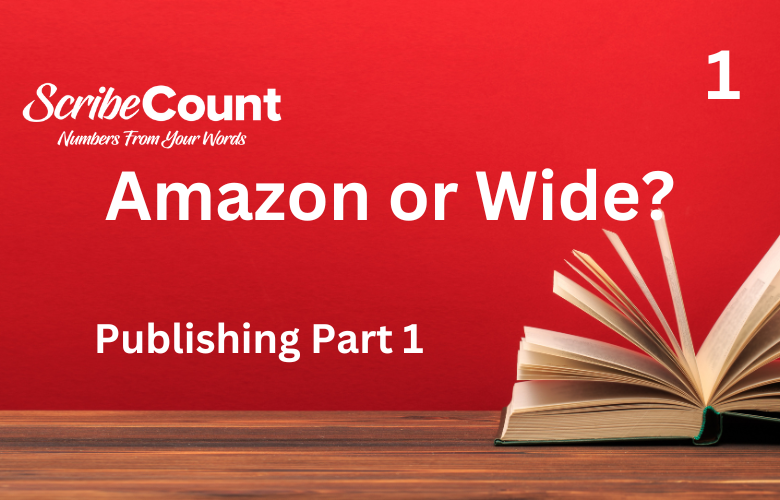Wide vs. Amazon's Kindle Unlimited. Where to start?
For a new indie author, the world of self-publishing presents authors with two primary distribution choices: publishing exclusively with Amazon's Kindle Unlimited (KU) or publishing wide, which means distributing books across multiple platforms like Apple Books, Kobo, Barnes & Noble, and Google Play. Each approach comes with distinct advantages and challenges, particularly in terms of potential profits, marketing requirements, and long-term career benefits. The debate about which road to take is ongoing and will likely remain that way for years to come. To help you understand the two options I've penned a pair of case studies. Hopefully they help you make the decision that is right for you and your goals.
The Kindle Unlimited Experience: A Case Study
Emma Parker always dreamed of writing romance novels, and when she finally published her first book, she was faced with a dilemma—should she go exclusive with Kindle Unlimited or distribute her book across multiple platforms? Unsure of how to market her work effectively, she opted for KU, attracted by the idea of Amazon’s massive readership and the promise of easy discoverability.
Within the first month, Emma saw moderate success. Her book was priced at $2.99, earning her a 70% royalty per sale. However, the real money came from KU page reads. As more readers borrowed her book through their KU subscriptions, she found herself making steady income from the Kindle Edition Normalized Pages (KENP) system, where authors are paid per page read. By the end of her first quarter, Emma had racked up over 300,000 page reads, netting her around $1,200 in addition to her direct sales revenue. Amazon’s ranking algorithm also favored her book since KU borrows contributed to visibility, helping her title gain momentum in the competitive romance genre.
However, Emma soon encountered some challenges. The exclusivity clause meant she couldn’t publish her book anywhere else for at least 90 days, restricting her ability to explore additional revenue streams. The fluctuating KENP payout rates added another layer of unpredictability to her earnings. While some months were lucrative, others saw a noticeable drop. And since her book was dependent on KU’s internal ecosystem, she realized that her success hinged entirely on Amazon’s policies and algorithms, leaving her vulnerable to sudden changes.
Exploring the Wide Publishing Model: A Different Approach
Meanwhile, across the country, Jake Thompson, a thriller writer, decided to take a different route. He had read about the risks of Amazon exclusivity and was keen on maintaining control over his work. Instead of enrolling in KU, Jake chose to distribute his books wide, leveraging platforms like Apple Books, Kobo, and Google Play. He also made his book available on his personal website, offering signed copies and direct sales.
At first, the results were discouraging. Unlike Emma, whose book quickly gained traction through Amazon’s ranking system, Jake had to work harder to build his audience. Without KU’s visibility boost, he relied on email marketing, BookBub promotions, and strategic Facebook ads to drive sales. The initial months were slow, and there were times he questioned his decision.
But by his second year, Jake’s patience paid off. His books gained loyal readers on platforms beyond Amazon, particularly in international markets like Canada and Australia, where Kobo had a strong presence. Unlike Emma, whose income was tied to KU’s fluctuating payout rates, Jake enjoyed a more stable revenue stream. While his books weren’t ranked as highly on Amazon, his diversified distribution meant he wasn’t reliant on a single platform for income. Over time, his direct sales also increased, allowing him to keep a larger percentage of the profits.
Profitability: A Side-by-Side Comparison
Emma’s success in KU provided her with immediate income. Her earnings in the first year were heavily driven by KU page reads, with an average monthly income of around $2,245 from a combination of KENP payments and direct sales. However, her success was largely dictated by Amazon’s algorithms, and when her book’s visibility declined, so did her earnings.
Jake’s wide publishing strategy started slowly, with earnings around $800 per month in his first year. But as he built his email list and secured promotional opportunities, his monthly income steadily climbed. By his third year, he was earning around $3,000 per month across multiple platforms, with additional revenue coming from direct sales and audiobook editions. His income was more predictable and resistant to sudden changes in a single marketplace.
Marketing Strategies: The Learning Curve
Emma and Jake both had to navigate the complex world of book marketing, but their approaches differed significantly. Emma focused on Amazon Ads, Kindle Countdown Deals, and free promotions, tools that worked well within KU’s ecosystem. She participated in newsletter swaps with other KU authors and took advantage of KU readers’ tendency to binge-read entire series.
Jake, on the other hand, relied on a broader marketing strategy. He invested heavily in Facebook and BookBub ads, targeted his email list with exclusive deals, and engaged with readers on social media. While Amazon Ads were less effective for him, he made up for it with strong sales on Kobo and Apple Books. Additionally, because his books weren’t exclusive to Amazon, he was able to run promotions on multiple platforms simultaneously, leading to more consistent income over time.
Transitioning from KU to Wide: A Strategic Move
Emma eventually decided to transition to wide publishing. She had built a loyal reader base in KU, but she wanted more control over her distribution. The transition wasn’t easy—many of her KU readers were hesitant to purchase books outside Amazon’s ecosystem. To ease the shift, she informed her email subscribers about her move, offered special discounts on her new releases, and encouraged direct sales through her website.
The transition period was financially tough, but over time, Emma’s efforts paid off. She started seeing steady sales on Apple Books and Kobo, and by her fourth year, she had fully established herself as a wide author. Her earnings were no longer at the mercy of KU’s payout fluctuations, and she had the freedom to sell her books in any market she chose.
The Kindle Unlimited Agreement: A Closer Look
Both Emma and Jake had to contend with the fine print of publishing contracts. Amazon’s KU agreement comes with exclusivity requirements that can limit an author’s flexibility. Books enrolled in KU must remain exclusive to Amazon for 90-day intervals, and violating this rule can result in penalties, including account suspension. The payout structure is also non-transparent—while Amazon announces the KENP rate each month, authors have little control over how much they will earn per page read. For some, this uncertainty is a dealbreaker.
Conclusion: Choosing the Right Path
Emma and Jake’s experiences highlight the fundamental differences between publishing exclusively with Amazon and going wide. For authors seeking quick visibility and an easier start, Kindle Unlimited can be an effective choice, particularly for those writing in high-engagement genres like romance and fantasy. However, the exclusivity requirements and fluctuating payouts pose risks, making it less ideal for long-term stability.
On the other hand, wide publishing offers greater control and diversified revenue, though it requires more effort in marketing and audience building. Authors willing to play the long game and invest in direct sales and multi-platform marketing can build a more sustainable career.
Most authors I know who have tried both options cite the learning curve for each as a major factor in their decision. Each platform requires some time and careful study in order to leverage it to its maximum sales benefit. Most adopt a "one at a time" approach that can take a year or more to complete. There are books and courses out there to help, but they can only serve as a guide, ultimately it will come down to time and how much of it you have to devote to your writing and marketing.
For new authors, starting with KU and later transitioning to wide can be a practical approach. By leveraging Amazon’s massive readership to build an initial fanbase, authors can gradually expand to other platforms once they’ve established themselves. Ultimately, the best choice depends on an author’s long-term goals and willingness to navigate the challenges of the self-publishing landscape.

